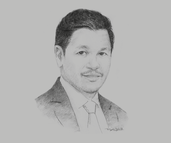Vitai Ratanakorn, Secretary-General, Government Pension Fund (GPF) : Interview

Interview : Vitai Ratanakorn
What new products will roll out in the near term?
VITAI RATANAKORN: When looking at arranging long-term benefits and investment schemes for our members, one of the key ways is through the introduction of life insurance products. In 2018 we are working to launch annuity, senior complex and labour mortgage programmes. Although these were launched in the past, they didn’t attract as much interest as expected because of regulatory or calculation issues. With the help of private insurers, re-launching these products will ensure quality of services, which might help address the ageing society issue. The risk factors are high when launching a new programme, even including good annuity products. There are pioneer costs that will make a programme seem unpromising at the outset, as the margins will be low. Therefore, in order to turn this into a reality, we need to restructure the system.
How ready are employers and employees for the introduction of a mandatory provident fund?
VITAI: There are a limited number of savers in the system, and to cope with an ageing population it is necessary for our society to create an agency to handle the mandatory provident fund. There are other adjustments to be made given our ageing population, and we will amend the GPF Act in 2018 to allow our members to save more by increasing the maximum saving percentage from 15% to 30%.
Of course, there will be concerns at the beginning from the employers in regards to contributions, but this has to be set up. If this becomes compulsory – by law – it will increase awareness and help develop a compulsory life savings plan. The employees, on the other hand, need to be ready – there’s no other choice. If we want to solve issues linked to an ageing society and avoid what Japan went through, we need to move fast. If we don’t act now, it will harm our economy. We need to promote, educate and encourage citizens to take part in this mission.
To what extent can overseas investments by the GPF and single-stock futures serve as a cooling mechanism for Thailand’s currency?
VITAI: The sole purpose of investing in foreign markets is to seek better returns. The risk adjustment return for asset classes in foreign markets is better than the local market, for both equity and fixed income, and for alternative assets. Presently, we have roughly 70 asset classes that are invested globally. All provide a better diversification with the correlation of the different asset classes, which can keep our returns stable and in a better position than most mutual funds in Thailand.
In regard to the number of asset classes, we are one of the most sophisticated investors in Thailand. However, with a stronger Thai baht we need to better manage our portfolio, because with each dollar we invest outside of Thailand we make a loss. Therefore, the hedging rate is one of the mandates we need to be careful with. Our hedging is quite high: we increased our position in hedging from 30% to 50%, and we will go further to solve the Thai baht currency issue, although we don’t need a 100% hedge as each of the asset classes has a negative correlation – we can pair some of the assets with other assets to have a close on returns. From overseas investments we sometimes get positive returns on one asset or negative assets on another, and positive returns on asset classes and a negative return on foreign exchange – all of which can offset each other.
At the moment, infrastructure is a promising alternative investment as the return generates a good hedge for inflation, which is beneficial in the long term. We haven’t invested as much in infrastructure projects – so far we have covered funds, but in the future we will allocate more towards alternative investments. At the present there is a lot of liquidity in Thailand, so we will need to invest more abroad and raise the cap of 30% on overseas investments.
You have reached the limit of premium articles you can view for free.
Choose from the options below to purchase print or digital editions of our Reports. You can also purchase a website subscription giving you unlimited access to all of our Reports online for 12 months.
If you have already purchased this Report or have a website subscription, please login to continue.

